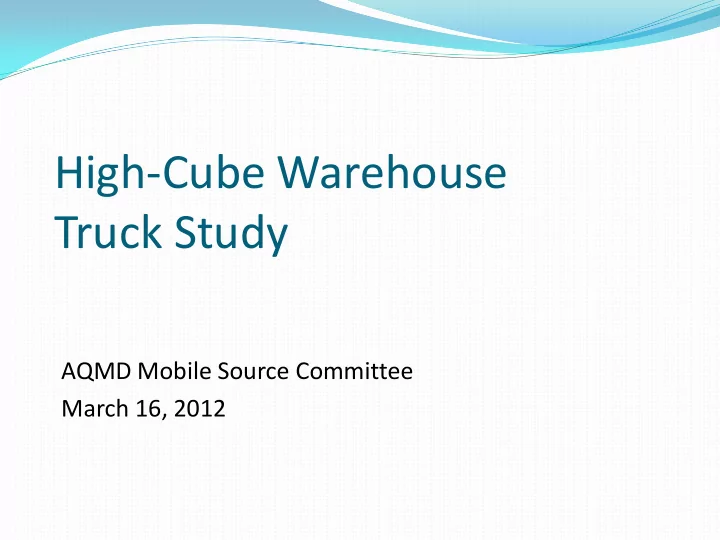

High-Cube Warehouse Truck Study AQMD Mobile Source Committee March 16, 2012
CEQA Air Quality Analysis AQMD’s Commenting Role AQMD staff recommends new warehouse projects evaluate potential air quality impacts for: Regional impacts Localized and Health Risk impacts AQMD staff recommends peak daily, voluntary default assumptions for analyzing air quality impacts for CEQA purposes Goal is to encourage full disclosure and implementation of mitigation where applicable and feasible 2
Background First AQMD warehouse study in 2002 investigated proliferation of warehouses in Mira Loma and Fontana Air quality and health impacts from warehouses due to diesel trucks (>90% of emissions) Warehouse projects continue to increase in numbers and size (>1 million ft 2 ) 412 million ft 2 of new warehousing projected in SCAG in next 25 years Ports of Los Angeles and Long Beach forecast tripling of containers in next 25 years New projects being developed now, including 40 million ft 2 in Moreno Valley 3
High-Cube Warehouse Used for the storage of manufactured goods prior to their distribution locally or regionally. Typically 24-30 feet tall Contain many dock doors for loading/unloading trucks Can facilitate many different types of operations 4
High Cube Warehouse Regular Warehouse 5
Estimating Truck Trips Overall Warehouse Trip Rate vs. Truck Trip Rate Overall Truck % Trucks Warehouse Trip Rate Trip Rate* *Overall warehouse trip rate includes truck and passenger car trip rate 6
Institute of Traffic Engineers (ITE) ITE is an international educational and scientific association of transportation professionals ITE Trip Generation Manual most commonly cited reference to determine trip rates for most land uses High Cube Warehouse Overall Trip Rates 7 th edition: 4.96/tsf No truck % provided 8 th edition: 1.44/tsf Truck rate = 44% or 0.64 /tsf 9 th edition: fall 2012 7
Assumptions Used by CEQA Projects Truck Truck Overall Rate % Rate Recent Projects with Development Overall Truck Truck % Size (ft. 2 ) CEQA Approval Trip Rate Trip Rate Banning Business Gateway 1 787,000 1.44 20% 0.29 South Perris Industrial 7,400,000 1.61 20% 0.33 Rialto Commerce Center 3,475,000 1.44 29% 0.41 Rados Distribution Center 1,191,000 1.1 53% 0.59 Palm Industrial 2 678,275 1.91 47% 0.90 West Ridge Commerce Center 937,260 1.69 54% 0.91 Mira Loma Commerce Center 3 782,398 4.96 20% 1.01 Project-specific Conditions: 1 Limit number of trucks/day, and only 2010+ trucks 2 Menu of potential measures to limit AQ impacts to what was disclosed in EIR 3 Only 2007+ trucks 8
Overall Trip Rate vs. Building Size 6.00 5.50 Individual Buildings from ITE studies Individual Buildings from Non-ITE studies Overall Trip Rate (trips per 1,000 square feet) 5.00 4.50 4.00 3.50 8 Buildings 3.00 95 th Percentile (voluntary default) 2.50 2.00 ITE Average 1.50 1.00 25 Buildings 0.50 0.00 0 200,000 400,000 600,000 800,000 1,000,000 1,200,000 1,400,000 1,600,000 Building Size (ft. 2 ) Study prepared in 2010 9
AQMD Staff Current Recommendation AQMD Staff current recommendation as voluntary default calculation: 2.59 1.04 40% trips/ Trip/1,000 Trucks 1,000 ft 2 ft 2 Preferably use project specific data with substantial evidence 10
AQMD Staff Rationale and Basis Overall default trip rate of 2.59 trips/1,000 ft 2 provides: Reasonable worst-case assumption sufficient for CEQA Consistency with AQMD regional and localized thresholds based on peak daily activity Default that can be replaced with project-specific data or an enforceable throughput limit Truck trip percentage of 40% represents: Average percentage from all available studies (2) Peer reviewed and response to comments documented Statistical methods 11
CEQA Legal Challenge 3.6 million ft 2 warehouse project in southern Rialto adjacent to homes Project approved in 2011 Cedar Avenue Project used ITE overall trip rate of 1.44 City and County of Riverside brought CEQA lawsuit over concerns about underestimation of truck traffic Lawsuit recently settled with Rialto agreeing to pay City and County of Riverside $3.5 million 12
Key Comments on Staff Approach COMMENTS RESPONSES 95% too conservative Use in conjunction with peak daily A. A. thresholds, and as voluntary default Average rates lower, but 95 th % B. Local trip rates lower than approach with local data yields B. national average similar results Staff used all available data and C. Staff analysis ‘cherry picked’ disclosed data development C. data ‘Vacancy’ has little impact on D. 95 th % (2.57 vs. 2.59); Staff analysis assumed vacancy D. caused low rates More robust data needed for E. Further study not necessary; CEQA air quality analysis E. staff should accept ITE 13
Current Efforts Convened two working groups to discuss study design Stakeholder working group warehouse developers, local government technical staff, environmental groups Technical working group Researchers, ITE representative, SCAG staff Engaged consultant to gather more robust data set for voluntary default factor Update CalEEMod upon completion of study (~6 months) 14
Proposed AQMD Warehouse Trip Study Design Phase I (6 months, $58,000) Collect information about existing population of 1. warehouses in AQMD region Send out approximately 500 short business surveys 2. Follow up phone call to approximately 250 businesses Classify 5 to 10 different types of high-cube warehouses 3. based on surveys Conduct on the ground trip counts 4. Determine trip rates for each warehouse classification 5. Phase II (2 months, $10-15,000) Develop model using results from Phase I 1. 15
Next Steps Continue working group meetings Periodic reports to MSC 16
Recommend
More recommend